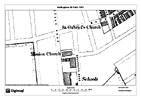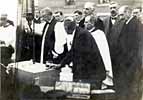 Wilford (North) Wilford (North)
St Faith
History
In the late 19th century the development of the City of Nottingham spread to the green flood plain on the north side of the River Trent, a part of the area known as the Meadows. This low lying land was once grazing land decorated each spring with swathes of purple crocus. Much of it was owned by Sir Hervey Bruce, Lord of the Manor of Wilford on the south bank of the river which, although within the city boundary, was part of the ecclesiastical parish of Wilford. Sir Hervey donated this land for the erection of a church, and a school was built to serve the new residents.
 The Mission Hall in 1901 The Mission Hall in 1901 |
In 1899 an ecclesiastical district was formed, designated as North Wilford, and a wooden framed, corrugated iron-clad Mission Hall, a daughter church of St Wilfred’s Church, Wilford, was erected on land which was originally to have been a cul-de-sac named Nethergate Street and was sandwiched between gardens adjacent to Whey House on the west and the Corporation waterworks to the east. The church records do not identify how this building was funded. Unfortunately the exact size of the mission building is not known and no images have been discovered, but from mainly maintenance reports it had at least two sizeable halls as well as other rooms. From historic Ordnance Survey maps it is possible to estimate its size as being 750 square ft. (70 square m.).
By 1900 the church found it necessary to rent rooms in the adjacent school to accommodate the activities it supported. The parishioners were predominantly working class, many of them working for the railway companies based at and around Nottingham Midland Station. In the first year of its founding the church offered weekly Bible Classes, Young People’s Groups, recreational meetings and a Band of Hope. In 1904 the need to manage the Mission Hall resulted in a local resident, Mr Prior, being appointed to the post of caretaker with a salary of 5s. (25p.) a week.
In 1905 major decisions were taking shape regarding the church’s future and by the end of the year the fund had reached £100, rising to £200 by the end of 1906. Bishop Hoskyns named the church St Faith, and a building fund was started to erect a more substantial structure. The new St Faith was licensed to perform marriages, but was still part of St Wilfred’s.
With the steadily increasing level of the building fund in 1908, including a commitment by the Nottingham Church Extension Society to donate £3 a year for seven years, it was decided to ask a Nottingham architect, W D Pratt of Long Row, to prepare designs for the new church. This appears to have taken rather a long time, for the plans are not mentioned again until 1910, when they were submitted to the Nottingham Spiritual Aid Society, who rejected them. Fundraising continued, however; Lord Henry Bentinck accepted the Chair of the Fundraising Committee and offered £500 if the Church Extension Society would match his offer, which they did.
In 1911 with the Building Fund now in a healthy state it was decided to hold a competition for the design of the new building. Six local architects, including W D Pratt, were invited to submit plans and Sutton and Gregory’s design was chosen. The cost of the build was estimated at £7,000, consisting of the building work at £4,200, plus the boundary wall and furnishings. This figure was later found to be inadequate due to the excavation work needed for the foundations. A local builder, James Wright, was awarded the contract to carry out the work which commenced in late 1913, after a donation of £2,000 from the Watson Legacy administered by the Nottingham Spiritual Aid Society in 1911, and a loan in 1913 from the Southwell Diocesan Loan Fund.
 Laying the foundation Laying the foundation
stone in 1913 |
The foundation stone was laid by Lord Henry Cavendish Bentinck on 25 October 1913. The collection at the ceremony totalled £25 17s. 6d. A container holding a newspaper and other items was placed under the stone. The inscription on the stone reads:
TO THE GLORY OF GOD
THIS STONE WAS LAID
BY
LORD HENRY
CAVENDISH BENTINCK M.P.
ON THE 25TH DAY OF OCTOBER 1913. |
With the building work progressing well the Bishop declared St Faith’s a separate parish in 1914. Despite a legacy of £2,000 from a Mrs Wilson it was decided that the south aisle would not be completed at this time, and a boarded wall was erected adjacent to the south arcade. This structure remained in situ until 1939. It is not known if the decision to curtail the work was due to a shortage of materials, labour or finance. The action reduced the seating from 600 to 400, but the building was well used with 11 Confirmations and 34 Baptisms in the first year of opening. The Sunday School roll was 236. The church was consecrated by the Bishop of Southwell on 16 October 1915.
St Faith’s church records of the 1920s and 1930s mainly show a steady development of church and social activities. Toilets were added in 1920, and a full time verger was employed at a salary of £1 15s. 1d. a week. Debate took place regarding the design of the proposed memorial to those parishioners who died in the Great War, and this dragged on from 1919-23, when Colonel Clifton was invited to unveil the carved oak panel sited in the baptistery.
The vicarage which was located on Wilford Grove was eventually sold and the incumbent the Rev. Sidney Belcher received a loan of £600 to buy the leasehold of a smaller house on Mundella Road. The freehold was purchased in the late 1930s. In 1958 the address given for the vicarage was Bathley Street, at the rear of the church.
Although war was imminent in 1939, St Faith’s commissioned the construction of the south aisle. Nottingham Building contractors Woodsends were awarded the contract at an estimated cost of £4,000. The new aisle is much narrower than the original planned in 1913.
Throughout the 1940s the church community was active. A blackout scheme was installed in 1940 at a cost of £136, and a fire watching group formed in 1941. In 1944 there were 13 confirmations and 62 baptisms. The ceremonial role of the church continued after the war with 45 marriages, 33 baptisms and nine burial services taking place in 1947. In 1948 discussions commenced on the nature of the memorial to those killed in the Second World War, and after a year of debate the decision was made to add a pair of hinged panels to the First World War memorial. Colonel Clifton once again officiated at the unveiling ceremony in September 1949, when over 300 people attended.
In a parish magazine of the same year the vicar commented that ‘the church is being used by only a few people’. Soon after his comments the Archdeacon suggested setting up a group to consider the future of St Faith’s, including a possible union with St Saviour’s, though nothing further on this issue appears in the records. From this point the church records become rather scant, with attention being focused on the day-to-day usage of the Mission Hall and its growing maintenance problems.
Throughout the 1960s the Mission Hall must have been a centre for local residents of all ages. It hosted the Mothers’ Union, Scouts, Guides, Brownies, a Kindergarten, Drama Group, Cubs, and a Youth Club, with over 300 hundred members. It was regularly let to the City Council during the daytime in school term time. During this latter part of the church’s history there was a high turnover of incumbents, with some periods without a vicar. One such interregnum lasted four years from 1972-76. In October 1976 the church organist and choirmaster, Keith Duckitt, was given a special token of thanks from the congregation for helping to keep the church open over the four year period.
The fate of St Faith’s was sealed in 1981 when the church was closed, followed by the building being declared redundant by Order in Council in 1983. The Elim Pentecostal church purchased the building. For several years it was used as a school and much altered internally, and it has now reverted to a church, The Full Gospel Revival Church and St Faith’s.
|